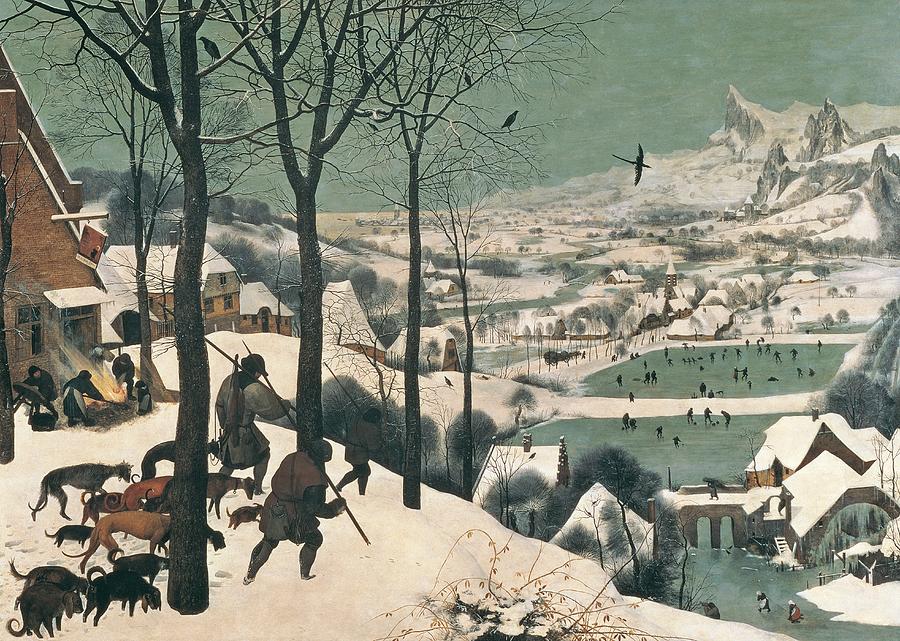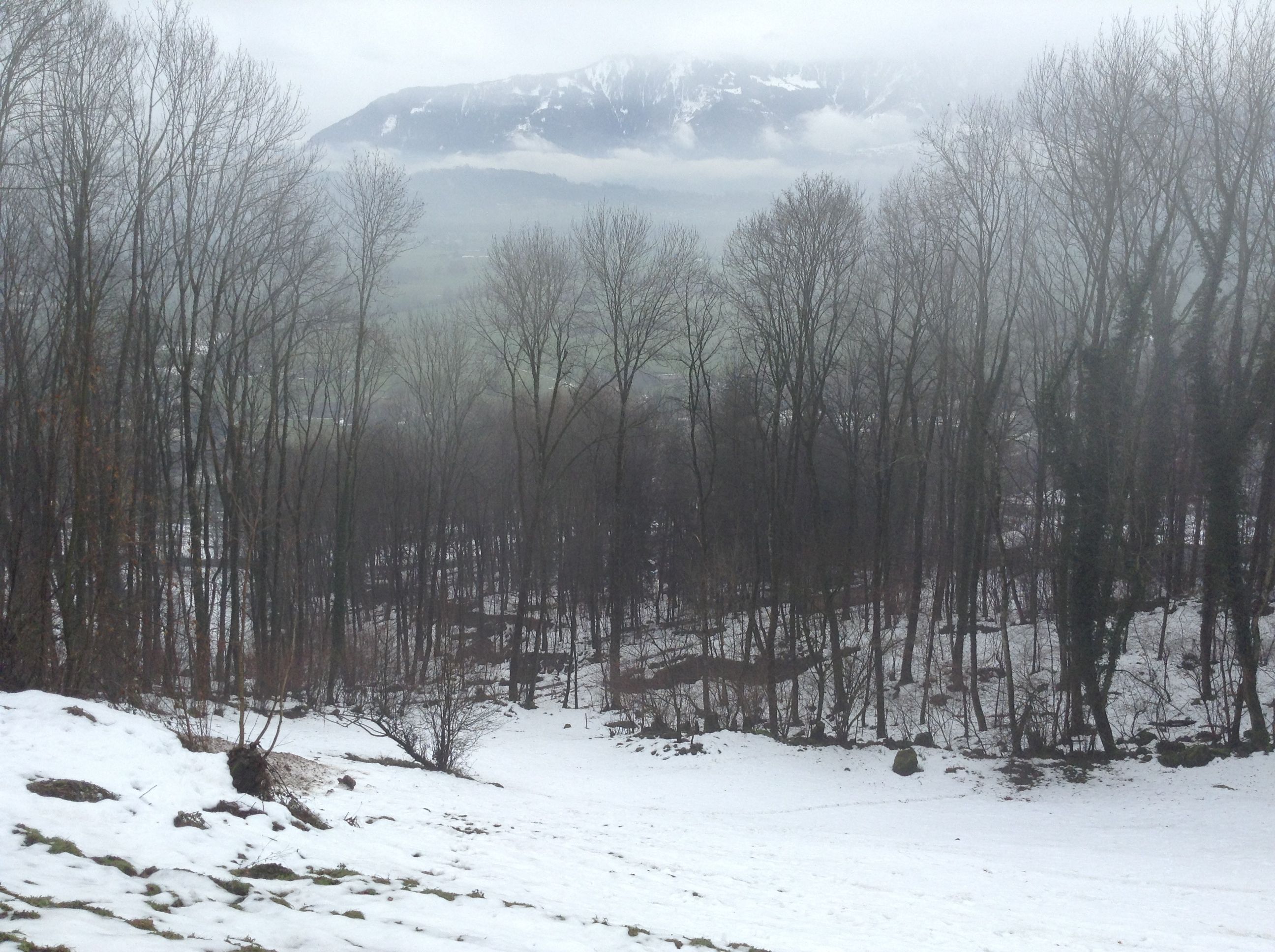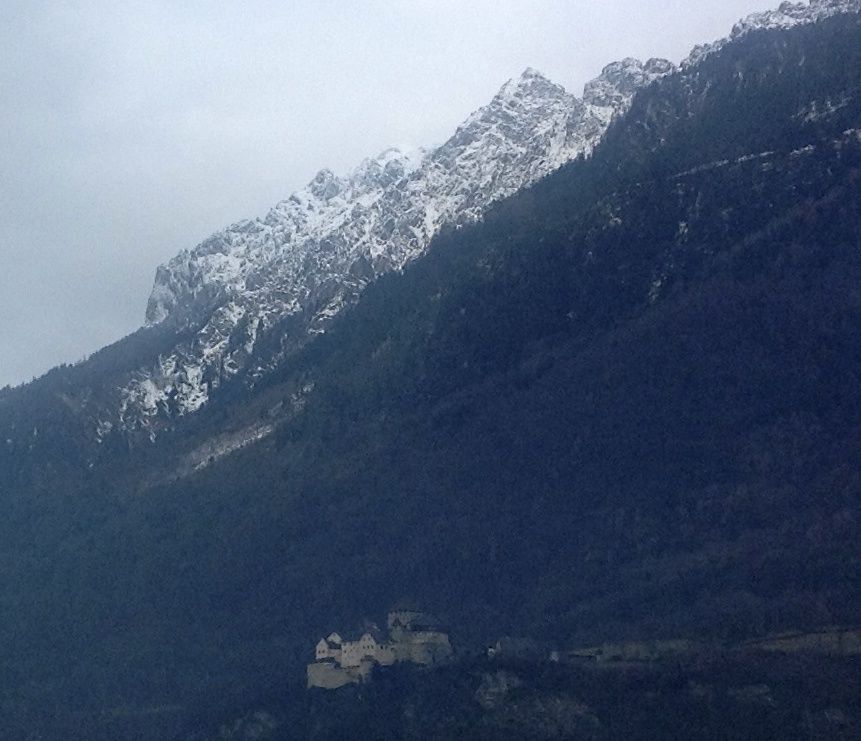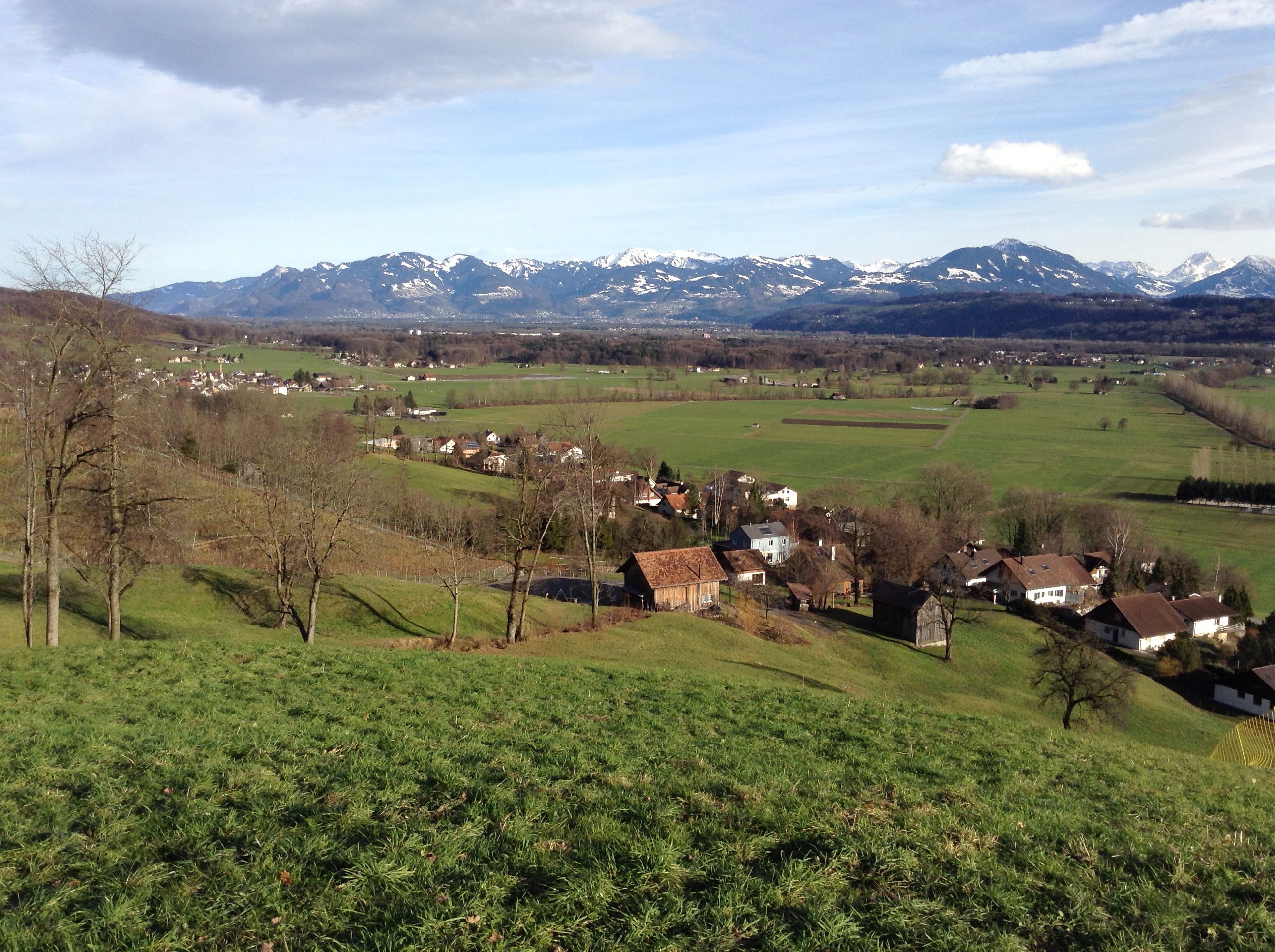
By Patrick Hunt –
One of the most beautiful paintings in the world, Bruegel’s 1565 Hunters in the Snow (117 x 162 cm) has received much attention for the return of the trudging “weary hunters with drooping shoulders…turning their backs to the observer…characterizing the season” [1] at top left and the harmonious depth of the sweeping landscape accented in diagonals from upper left to lower right and up again at upper right. The warmth of the fire with brush burning contrasts with the frozen lakes and icy peaks. The gray-green sky is the color of lead with thick clouds that hide the dim sun during the short daylight. The hunters have not been very successful with a meager catch, likely only a single animal hanging from the poles.
The diagonal line of bare poplar or elm trees move the viewer’s eyes right to the edge of the foreground steep hill, repeated by the brown houses, behind them the gray bare wooded copses like holm oaks along the rounded hills, then pick up again at the bottom in a continuing line across the valley along the ice ponds. Famous for the realism of his landscapes with the interplay of humans and nature, Bruegel’s artistic plan hints how human activity adapts to an environment both majestic but indifferent, where we are only one part in contrast to the dead of winter where life is otherwise mostly still.
The inn on the left has its sign hanging by only one hook, waiting like the rest of the world for repair when life restarts. What water is trapped in the snow and ice ponds is mostly inaccessible. The mostly vertical foreground trees – contrasting with the far high horizon – are empty except for snow laying on the branches and a few black huddled birds, with one taking wing across the landscape high over the valley but still touching the far crags. The slight back sweep of the wings of the dark bird in flight with its long tail in contrast to the light background suggests to some a silhouetted kestrel, itself a hunter in the winter, but even if not, Bruegel as keen observer makes it likely this is a known bird. The village church bell towers echo but in orthogonal human fashion the ragged vertical peaks, both an antithesis and synthesis of human versus nature.
This painting has also inspired many ekphrases including a celebrated poem by John Berryman with the hunters “returning cold and silent to their town” – a transposition d’art [2] – and a world-famous short story by Tobias Wolff as well as multiple cinematic creations. Part of a Bruegel series on seasonal images, this one is winter and generally thought of as either December [3] or January [4], as representational calendars of art were a known precedent.[5]
I have often wondered where this topography can be found, and am certainly not the first, formerly thinking it universal and generic. But recently I’ve come to possibly recognize aspects of the landscape. Of course, Bruegel’s imagination was perfectly capable of inventing a composite landscape made of different loci. In the last few years, however, I’ve spent weeks in the Rheintal south of Bavaria between the upper Canton of St. Gallen above the Bodensee where Switzerland, Austria and Liechtenstein converge. In fact, I’m looking across this valley now from a chalet in the Kreuzberg this week before Christmas. I can see the castle of Vaduz at the base of the Alpspitz, the Helwangspitz and the steep mountains of Liechtenstein, very much as Bruegel painted the castle at the base of the cliffs on the right. The same lines of bare poplars and other woods stretch out across the valley where holm oaks and elms fill in the low places. It’s important to remember that travelers would not have so likely have traveled in winter but rather in summer months or on the edges of it. But it’s also possible that snowstorms in this alpine region could have come on either the earlier or later edges of main travel seasons.

For years before the Rhine was straightened out and diked this valley was subject to meandering and flooding out of the adjacent Alps, so there were marshy riparian areas and ice ponds just like the ones on Bruegel’s landscape. Some holding ponds can still be seen closer to the Rhine River, the boundary here between Switzerland and Liechtenstein. The villages like Sax, Frumsen, Sennwald on the west side of the valley or Eschen, Gamprin, Mauren and Schellenberg on the east side each have their church bell towers like in Bruegel’s painting. Many of the surviving Renaissance Era bell towers in the Rheintal are still square and exactly like these in the painting, only they are now whitewashed like their old churches. Overall aspects of this valley can be matched to the painting from either east or west views. Are all these similarities just coincidence or pastiches recorded in Bruegel’s sketchbooks? Or is the resemblance more than passing and imaginary?

Here below is a recent photo of the village of Hueb-Sax Dorf on the west side of the Rheintal looking east to Austria that also bears some resemblance to the painting, assuming Bruegel could have substituted in the more dramatic Vaduz Castle and crags above it from sketches.

The Sax-Hueb landscape has lines of trees, including elm and poplar, along old property lines that have existed hear for hundreds of years in the local communes, similar to Bruegel’s landscape.
We know Bruegel visited Rome in 1553 and would have passed through Alpine topography much like this in the painting, which definitely isn’t the Low Countries. From Antwerp to Rome, old Roman roads and medieval roads ran south the length of the Rhine River valley (Rhenum) to Chur (Roman Curia) especially along the Hinterrhein branch then turned off high in the Alps toward various different passes but especially the Julier which lead down to Milan (Mediolanum) and southward to Rome. [6] It is important for this argument that the Rhine valley was easily the most-traveled Medieval and Renaissance routes to Rome from the Low Countries where the Rhine began. In the Rheintal a section of this old Roman road spanned the River Ill flowing into the Rhine, with a Roman bridge roughly where Holy Cross bridge remains in Feldkirch, the westernmost city of Austria on the eastern Rhine valley side. If Bruegel’s view is northward roughly from the hills of Sevelen in St. Gallen Canton eventually toward the flat Bodensee and Bavaria, Vaduz Castle is in this approximate location under the Alpspitz of modern Liechtenstein, but this is only one possibility that the landscape fulfills and it may more easily be a composite image rather than a fixed landscape.
Art biographer Karel van Mander (15548-1606) affirms in his Schilder-boeck that Bruegel had filled sketchbooks of many such landscapes on his journey, [7] as Orenstein repeats and also states, “Bruegel’s study of the Alps must have been thorough and he probably filled several sketchbooks with Alpine views” although none of the original sketches survive. [8] Elsewhere Orenstein is right to claim “mountain vistas that had deeply impressed the artist as he made his way through the Alps rank among his most widely circulated and celebrated works.” [9] Clearly that summation includes Hunters on the Snow.
In retrospect, although many such composite topographies could be rendered in such a painting as this, from now on I will suspect Bruegel’s observant eyes roamed across this very place where I now gaze across the Rheintal and remembered it accordingly, reinforced by sketched details one may still see.
Notes:
[1] Rose-Marie Hagen. Bruegel: The Complete Paintings. Cologne: Taschen, 2000, 2nd ed., 62-3 & ff.
[2] Arthur and Catherine Evans. “Pieter Bruegel and John Berryman: Two Winter Landscapes.” TSLL 5.3 (1963) 309-18.
[3] Walter Stechow. Bruegel. New York: Abrams, 1954, 3 (December).
[4] Max Julius Friedlaender. Pieter Bruegel. Berlin, 1921, 106 (December or January).
[5] N. Lobkova. The Cycle of the Year: The Genre of Calendar Illustrations from Origins to Lucas and Martin van Valckenborch. Vol. 1. MA Thesis for Ghent University, 2010. esp. Bruegel’s “Hunters in the Snow”, ch. 4 on Bruegel’s Twelve Month Cycle and 59-60 ff.
[6] A. M. Snodgrass. “The Early History of the Alps.” The Alpine Journal 98 (1993) 213-22, esp. 220. Along with Ludwig Pauli’s earlier (1984) study, this vital article remains one of the best accounts of Alpine history.
[7] Karel van Mander. Livres des Peintres: Vies des plus Illustres peintres des Pays-Bas et d’Allmagne. Veronique Gerard-Powell, ed. Paris: Les Belles Lettres, 2002, 187-92.
[8] Nadine Orenstein, ed. Pieter Bruegel the Elder: Prints and Drawings. New York: Metropolitan Museum of Art, 2001, 30.
[9] ibid., 120.